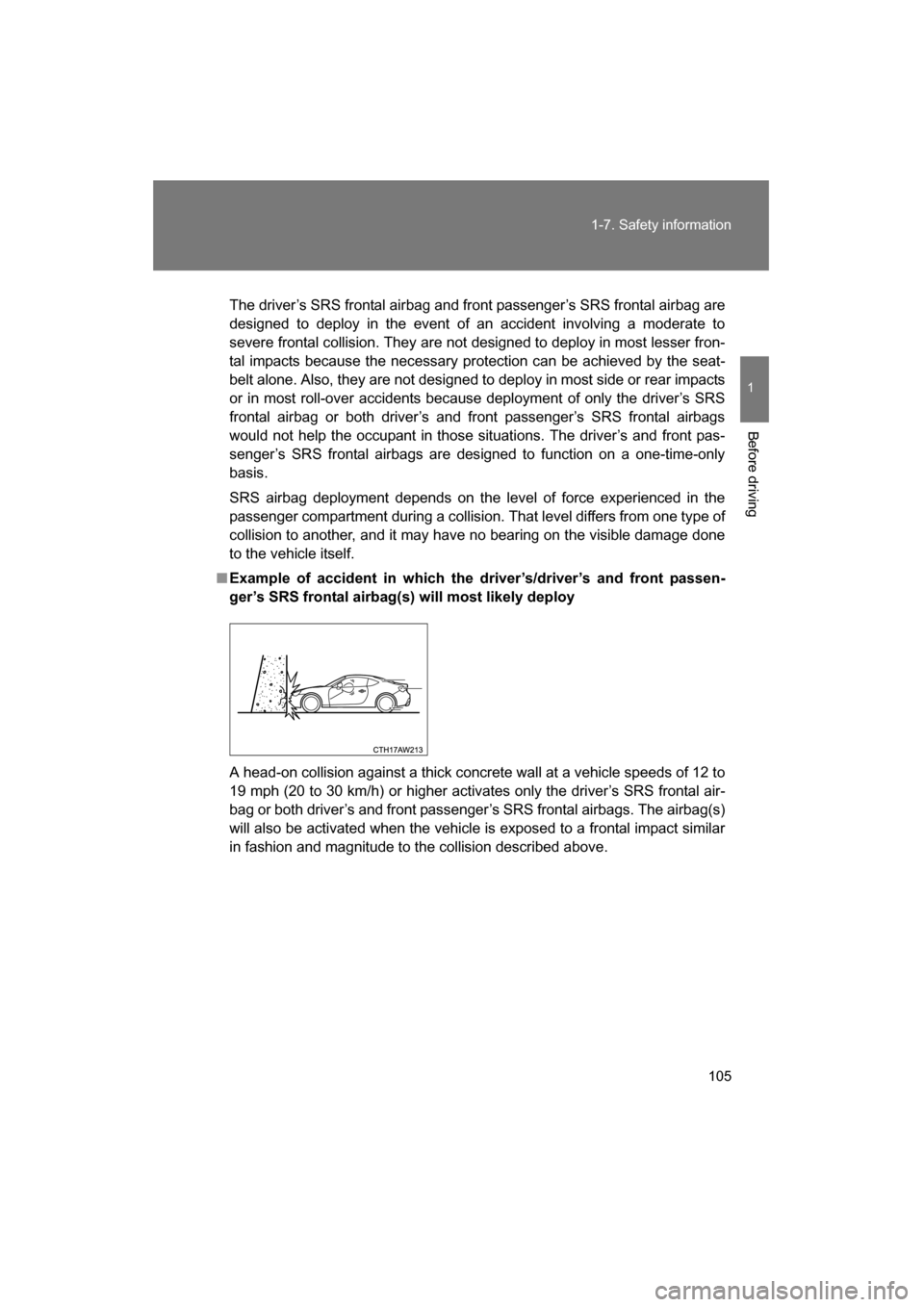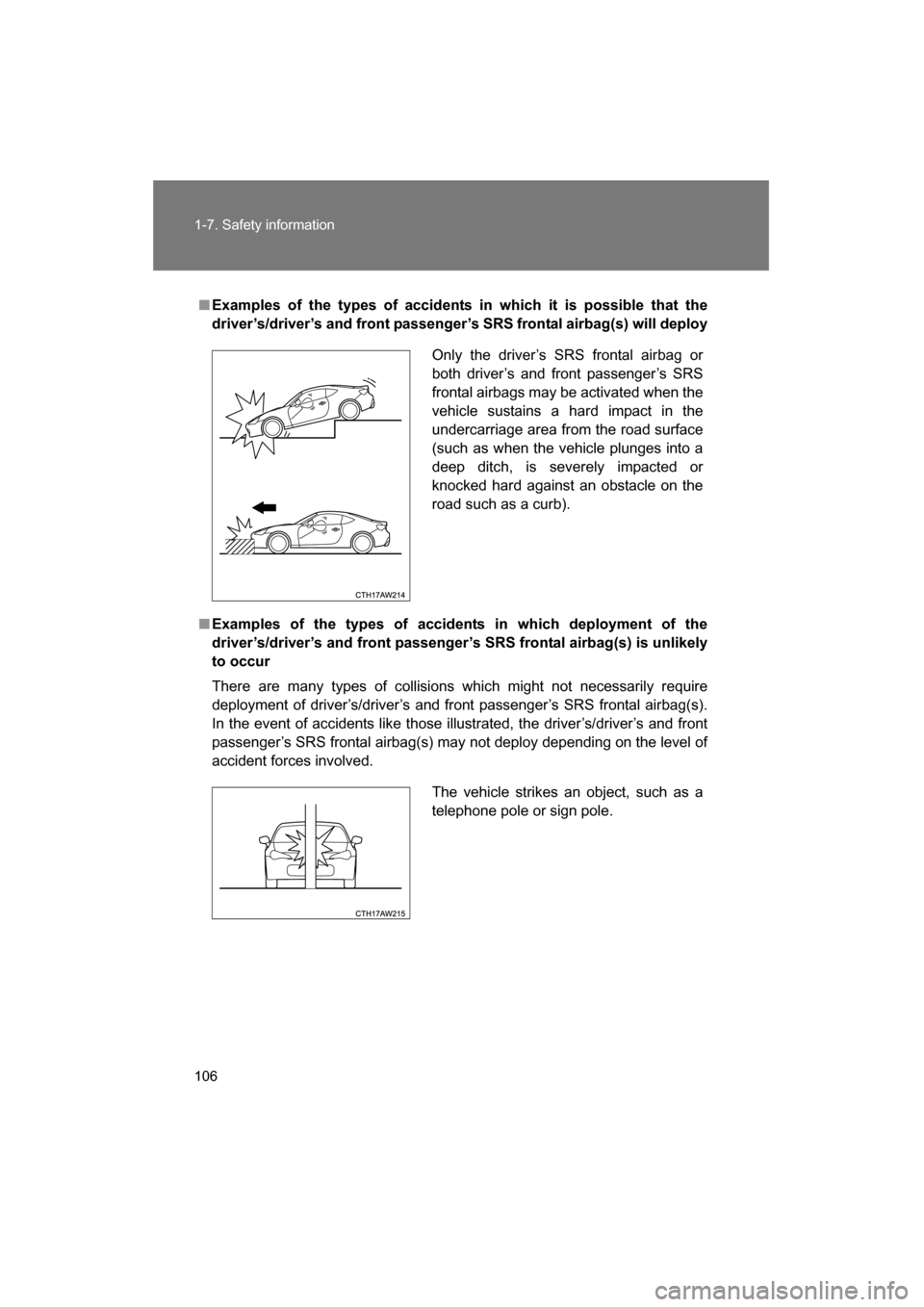Page 103 of 492
103
1-7. Safety information
1
Before driving
■OperationDriver's side
Passenger’s side SRS AIRBAGs deploy as soon as a
collision occurs.
After deployment, SRS AIRBAGs start to deflate immediately so that the
driver’s vision is not obstructed.
SRS AIRBAGs deploy as soon as acollision occurs.
After deployment, SRS AIRBAGs start to deflate immediately so that the
driver's vision is not obstructed.
Page 104 of 492

104
1-7. Safety information
The SRS airbag can function only when the ignition switch is in the “ON”
position.
The SUBARU advanced frontal airbag system is designed to determine the
activation or deactivation condition of the front passenger’s SRS frontal air-
bag depending on the characteristic of the item(s) or person on the front
passenger’s seat monitored by the front passenger’s occupant detection
system sensor. For this reason, only the driver’s SRS frontal airbag may
deploy in the event of a collision, but this does not mean failure of the sys-tem.
If the front sub sensors and the impact sensors in the airbag control module
detect a predetermined amount of force during a frontal collision, the control
module sends signals to the airbag module(s) (only driver’s module or both
driver’s and front passenger’s modules) instructing the module(s) to inflate
the SRS frontal airbag(s).
The driver’s and front passenger’s SRS frontal airbags use dual stage infla-
tors. The two inflators of each airbag are triggered either sequentially or
simultaneously, depending on the severity of impact, in the case of the
driver’s SRS frontal airbag and depending on the severity of impact and the
characteristic of the item(s) or person on the seat in the case of the front
passenger’s SRS frontal airbag.
After deployment, the SRS airbag immediately starts to deflate so that the
driver’s vision is not obstructed. The time required from detecting impact to
the deflation of the SRS airbag after deployment is shorter than the blink of
an eye.
Both when only the driver’s SRS frontal airbag deploys and the driver’s and
front passenger’s SRS frontal airbags deploy, the driver’s and front passen-
ger’s seatbelt pretensioners operate at the same time.
Although it is highly unlikely that the SRS airbag would activate in a non-
accident situation, should it occur, the SRS airbag will deflate quickly, not
obscuring vision and will not interfere with the driver's ability to maintain con-
trol of the vehicle.
When the SRS airbag deploys, a sudden, fairly loud inflation noise will be
heard and some smoke will be released. These occurrences are a normal
result of the deployment. This smoke does not indicate a fire in the vehicle.
Page 105 of 492

105
1-7. Safety information
1
Before driving
The driver’s SRS frontal airbag and front passenger’s SRS frontal airbag are
designed to deploy in the event of an accident involving a moderate to
severe frontal collision. They are not designed to deploy in most lesser fron-
tal impacts because the necessary protection can be achieved by the seat-
belt alone. Also, they are not designed to deploy in most side or rear impacts
or in most roll-over accidents because deployment of only the driver’s SRS
frontal airbag or both driver’s and front passenger’s SRS frontal airbags
would not help the occupant in those situations. The driver’s and front pas-
senger’s SRS frontal airbags are designed to function on a one-time-only
basis.
SRS airbag deployment depends on the level of force experienced in the
passenger compartment during a collision. That level differs from one type of
collision to another, and it may have no bearing on the visible damage done
to the vehicle itself.
■Example of accident in which the driver’s/driver’s and front passen-
ger’s SRS frontal airbag(s) will most likely deploy
A head-on collision against a thick concrete wall at a vehicle speeds of 12 to
19 mph (20 to 30 km/h) or higher activates only the driver’s SRS frontal air-
bag or both driver’s and front passenger ’s SRS frontal airbags. The airbag(s)
will also be activated when the vehicle is exposed to a frontal impact similar
in fashion and magnitude to the collision described above.
Page 106 of 492

106
1-7. Safety information
■Examples of the types of accidents in which it is possible that the
driver’s/driver’s and front passenger’s SRS frontal airbag(s) will deploy
■Examples of the types of accidents in which deployment of the
driver’s/driver’s and front passenger’s SRS frontal airbag(s) is unlikely
to occur
There are many types of collisions which might not necessarily require
deployment of driver’s/driver’s and front passenger’s SRS frontal airbag(s).
In the event of accidents like those illustrated, the driver’s/driver’s and front
passenger’s SRS frontal airbag(s) may not deploy depending on the level of
accident forces involved. Only the driver’s SRS frontal airbag or
both driver’s and front passenger’s SRS
frontal airbags may be activated when the
vehicle sustains a hard impact in the
undercarriage area from the road surface
(such as when the vehicle plunges into a
deep ditch, is severely impacted or
knocked hard against an obstacle on the
road such as a curb).
The vehicle strikes an object, such as a
telephone pole or sign pole.
Page 108 of 492
108
1-7. Safety information
■Examples of the types of accidents in which the driver’s/driver’s and
front passenger’s SRS frontal airbag(s) will basically not deployThe driver’s and front passenger’s SRS
frontal airbags are designed not to deploy
in most cases if the vehicle is struck from
the side or from behind, or if it rolls onto
its side or roof, or if it is involved in a low-
speed frontal collision.
First impact
Second impact
In an accident where the vehicle is
impacted more than once, the driver’s
and/or front passenger’s SRS frontal air-
bag(s) will deploy only once on the first
impact.
Example: In the case of a double colli-
sion, first with another vehicle, then
against a concrete wall in immediate suc-
cession, once either or both of the driver’s
and front passenger’s SRS frontal air-
bags is/are activated on the first impact,
it/they will not be activated on the second
impact.
Page 109 of 492
109
1-7. Safety information
1
Before driving
WARNING
■If the SRS airbags deploy
Do not touch the SRS airbag system components around the steering wheel
and dashboard with bare hands right after deployment. Doing so can cause
burns because the components can be very hot as a result of deployment.
■Child restraint precautions
NEVER INSTALL A REARWARD FACING CHILD SEAT IN THE FRONT
PASSENGER’S SEAT EVEN IF THE FRONT PASSENGER’S SRS FRON-
TAL AIRBAG IS DEACTIVATED. Be sure to install it in the REAR seat in a
correct manner. Also, it is strongly recommended that any forward facing
child seat or booster seat be installed in the REAR seat, and that even chil-
dren who have outgrown a child restraint system be also seated in the
REAR seat. This is because children sitting in the front passenger’s seat
may be killed or severely injured should the front passenger’s SRS frontal
airbag deploy. REAR seats are the safest place for children.
Page 110 of 492
110
1-7. Safety information
SRS side airbag and SRS curtain airbagThe SRS side airbag is stored in the door side of each front seat
seatback, which bears an “SRS AIRBAG” label.
In a moderate to severe side impact collision, the SRS side airbag on
the impacted side of the vehicle deploys between the occupant and
the door panel and supplements the seatbelt by reducing the impact
on the occupant’s chest and waist. The SRS side airbag operates
only for front seat occupants.
The SRS curtain airbag on each side of the cabin is stored in the roof
side (between the front pillar and a point over the rear seat). An “SRS
AIRBAG” mark is located at the top of each front and rear pillar.
In a moderate to severe side impact collision, the SRS curtain airbag
on the impacted side of the vehicle deploys between the occupant
and the side window and supplements the seatbelt by reducing the
impact on the occupant’s head.
Page 111 of 492

111
1-7. Safety information
1
Before driving
■Operation
The SRS side airbag and SRS curtain airbag can function only when the
ignition switch is in the “ON” position.
The driver’s and front passenger’s SRS side airbags and SRS curtain air-
bags deploy independently of each other since each has its own impact sen-
sor. Therefore, they may not both deploy in the same accident. Also, the
SRS side airbag and SRS curtain airbag deploys independently of the
driver’s and front passenger’s SRS front airbags in the steering wheel and
instrument panel.
An impact sensor, which senses impact force, is located in each of the left
and right center pillars, doors and rear wheel houses. Another impact sen-
sor, which also senses impact force, is located under the center of the rear
seats.
If the impact sensor that is located under the center of the rear seats and
one of the center pillar impact sens ors or door impact sensors together
sense an impact force above a predetermined level in a side collision, the
control module causes both the SRS side airbag and curtain airbag on the
impacted side to inflate regardless of whether the rear wheel house impact
sensor on the same side senses an impact.
If the impact sensor that is located under the center of the rear seats and
one of the rear wheel house impact sensors together sense an impact force
above a predetermined level, the control module causes only the SRS cur-
tain airbag on the impacted side to inflate.
After the deployment, the SRS side airbag immediately starts to deflate. The
time required from detection of an impact to deflation of an SRS side airbag
after deployment is shorter than the blink of an eye.
The SRS curtain airbag remains inflated for a while following deployment
then slowly deflates.